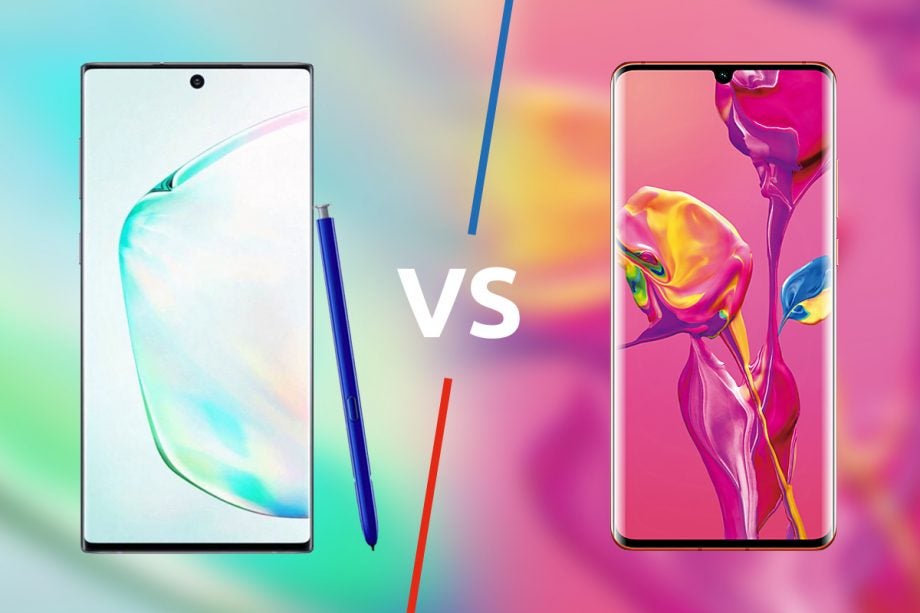Samsung Galaxy Note 10 Plus vs Huawei P30 Pro: Which should you buy?

The long-awaited Samsung Galaxy Note 10 Plus has just launched and a key feature for Samsung’s new flagship handset is its quad-camera setup. But how does it hold up to the photo-snapping king that is the Huawei P30 Pro? We compare the best (and most pricey) that Samsung and Huawei have to offer.
Note 10 Plus vs Huawei P30 Pro: So many sensors
The P30 Pro is the current occupant of the top slot for versatility in our best camera phones roundup but in terms of the sheer number of sensors at play, its four-camera array is trumped by the Note 10 Plus’ five. The new Note has twice the number of rear cameras as that of its predecessor, the Galaxy Note 9.
It comes with a quad sensor setup on the rear of the smartphone, combining a 16-megapixel ultra-wide sensor with an f/2.2 aperture, a 12-megapixel regular wide-angle camera with a variable f/1.5 to f/2.4 aperture, a 12-megapixel telephoto sensor with an f/2.1 aperture and a VGA ‘DepthVision’ camera with a super-wide f/1.4 aperture. The regular wide-angle camera and the telephoto lens both come with optical image stabilisation (OIS) – always a bonus for shaky hands, especially when your shot requires a lot of zooming in.
The P30 Pro, on the other hand, comes kitted out with three cameras on its back. The P30’s main camera sensor is a massive 40-megapixel wide-angle lens with optical image stabilisation, a wide f/1.6 aperture and an unorthodox RYYB pixel arrangement as opposed to the usual RGB setup used by most smartphones. The handset also comes with a 20-megapixel ultra-wide lens with an aperture of f/2.2 and an 8-megapixel telephoto lens with an aperture of f/3.4 and, again, OIS.
The 32-megapixel front camera on the P30 has a wider (f/2.0) aperture than the Note 10 Plus’ 10-megapixel (f/2.2) front camera, which suggests it should be capable of taking selfies with a little more depth. However, the Note 10 Plus’ DepthVision selfie camera looks ideal for creating bokeh, thanks to its super-wide aperture.
In our review of the P30 Pro, we praised the telephoto abilities on the Huawei flagship for “the best zoom you can currently find on any smartphone”. The Note 10 Plus’ telephoto sensor looks to be a strong contender for this title with an additional four megapixels to boot. That being said, it stands to be seen whether the Note 10 Plus can beat Huawei’s impressive 10x hybrid zoom.
Another quality we loved in the P30 Pro was the camera’s performance at night and in low light situations. We noted that “thanks to its f/1.6 aperture, the P30 Pro has been able to shoot at a lower ISO and managed much more even exposure across the frame”. The Note 10 Plus’s regular wide-angle camera is capable of shooting at f/1.5, meaning it might actually be able to stand up to the P30 in low light without losing too much detail.
We’ll have to spend more time with the Note 10 Plus to know for sure how it compares to the P30, however.
Note 10 Plus vs Huawei P30 Pro: Huge displays
The P30 Pro’s 6.47-inch OLED screen is almost as big as the 6.8-inch AMOLED Infinity-O display on Samsung’s biggest phablet, though the Note 10 Plus’s 3040 x 1140 HDR10+ resolution is significantly bigger than the 2340 x 1080 FHD+ resolution on the P30. Both displays are pretty advanced with in-display and face unlock features too, although Samsung’s ultrasonic in-display sensor is supposedly more capable.
Note 10 Plus vs Huawei P30 Pro: Exynos vs Kirin
The Note 10 Plus comes kitted out with the new 7nm Exynos CPU. The 7nm is a pretty nice step up from the 8nm Exynos 9810 on previous Samsung handsets because it requires significantly less power to run. The performance probably won’t differ too dramatically from that of the Note 9 but we might see a boost in battery life with the latest addition to the Note family.
The Huawei P30 Pro features the Kirin 980 chipset which is built using the same 7nm architecture as the Exynos. This again equals nice efficient battery life, as well as super-speedy performance, even when gaming.


